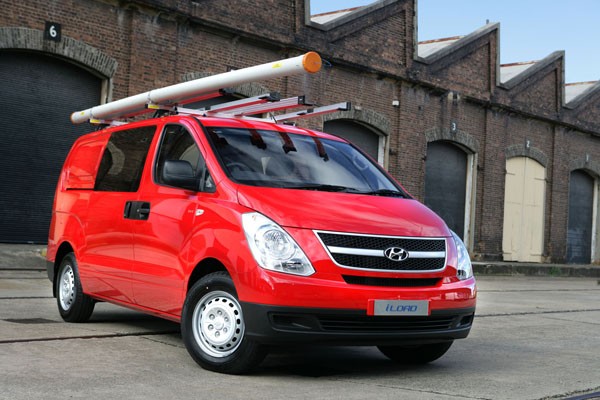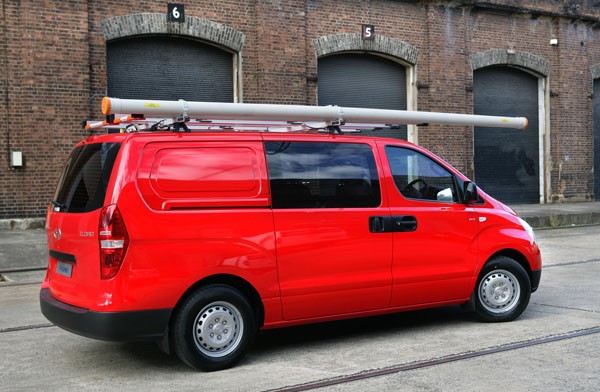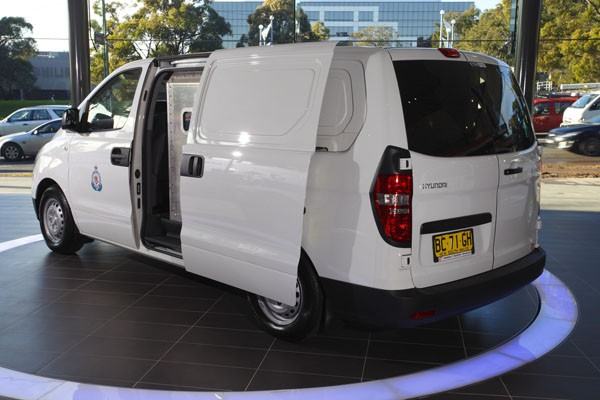
So far this year, light commercial vans have accounted for over 13,000 units. Of those, almost a half are Toyota HiAces. The next van off the loading dock is the Hyundai iLoad, with just under 4000 sales, or around twenty-one percent of the market. There’s a lot of daylight between the iLoad and the rest.
Year to date this sector is growing at a healthy four percent over 2013. Clearly a lot of people have a choice to make about which big white van they’re going to be spending a huge amount of time in for around three or four years – is the Hyundai iLoad a worthy companion?
VALUE
The iLoad is available with one 2.0-litre petrol and two 2.5-litre diesel engines, with a choice of six-speed manual or five-speed automatic transmissions.
The iLoad range starts with the steel-wheeled manual 2.4-litre petrol at $30,990, with the diesel manual coming at $36,490.
Ours was the mid-range automatic diesel which weighs in at $38,990. For that you get a van the size of the Queen Mary, a basic cloth cabin with vinyl, hose out floors and a surprisingly powerful air-conditioner.
There are quite a few options. Metallic paint (silver or black) at $695; and barn doors at the rear for $550 to replace the tailgate. A rear parking camera is a pricey $1337, the rubber floor in ours added $554, the cargo barrier $707, the plastic curtain a further $245.
You can have a wooden floor for $554, canvas seat covers for $187, a portable cooler for $336 and tailored floor mats for $103 (rubber) or $125 (carpet). The nudge bar was $810, tow bar is $903. The list seems to go on forever, fair enough in the commercial field where operators have many differing needs.
DESIGN
It’s a big box. Looks don’t really matter in this space so it’s practicality that really matters.
The tailgate opens high (or you can spec the double barn doors if you work in height-restricted areas) to a 4.3 cubic metre load bay. At its narrowest, the floor is 1260 mm wide between the wheel arches, or 1620 mm at its widest. The flat vinyl-covered floor is 2375 mm long and 1350 mm high.
Obviously, you can jam a lot of stuff in here. Including wardrobe-shaped stuff when your brother gets wind that you’ve got a big van.
Both sides have sliding doors and they have a good, easy action and big grab handles for when your hands are full and you don’t want to faff around. In fact, there’s nothing fiddly on the iLoad – everything seems a bit Fisher-Price until you remember that these are workhorses and it all makes sense.
The cabin is open to the load bay but you are separated by a cage and you can also put up a plastic curtain. There’s a single driver’s seat along with a two person sliding bench. The central stack pokes out towards the middle seat, so you’ll want to be short if you expect to fit between driver and outboard passenger.
On the outside, ours had a nudge bar and some not-so-racy 16-inch alloys.
SAFETY
Dual airbags, ABS, traction control, brake force distribution and pre-tensioned and load limited front seatbelts make for a four-star ANCAP rating. The diesel also features stability control.
INFOTAINMENT
Slim pickings here, but the tradies’ friend has a two-speaker stereo with Bluetooth and USB input, perfect for blaring out the sort of thing Triple M usually plays or better to hear a ranting talkback host over your McMuffin. It’s an old-style stereo unit with an LCD display but does the job.
ENGINE / TRANSMISSION
The Hyundai iLoad’s diesel is a big 2.5-litre, four-cylinder turbo, producing 125 kW of power and 441 Nm of torque – as long as you spec that five speed automatic. Without the auto, your load-lugging will be slower. The manual iLoad might have one extra gear, but drops 25 kW and almost a 100 Nm.
Hyundai claims 8.8 litres per 100km in this form, which isn’t terrible when you discover its empty weight is 2062 kg.
DRIVING
The front doors open very wide and stepping in requires holding the grab handle and pulling oneself in. Once aboard you’ve got a pretty impressive view as the bonnet drops away over the front wheels.
Some vans are horrendous. You sit over the wheels, your legs dangling in the footwell. The iLoad feels a bit more secure than the average van with a flat floor for the passengers to clamber across if they need to.
If you drive an iLoad empty, you’ll be bouncing around as though aboard the Rubber Dinghy Rapids. Without any weight in the back you can even spin the rear wheels, although if a van this big got away from you’d probably wipe out a postcode.
Progress is far more civilised once loaded up – the iLoad can carry 1113 kg in this configuration. The cavernous rear stops being a megaphone for driveline noise and it gets to the point where it genuinely feels like a big car, or at least a reasonably well-sorted MPV.
There are ten rings for securing your load and the (optional) rubber floor is a big help in stopping things sliding around. Loading up bulky items – like sibling-owned wardrobes – it’s handy to have access from both sides, with good sized steps to get your feet on.
The cage also protects you from flying loose items when you have to stop (the brakes are actually very good) although the plastic curtain will be even better if, like us, you had rolls of turf in the back that unrolled and sprayed the cabin with soil. A quick vacuum and a broom and all was right with the big Hyundai again.
The power steering is pretty light and the transmission not bad for a commercial vehicle. If you have to drive for a living, you won’t hate it. It is a bit loud, though.
SUMMING UP 3.5/5
When sampled in isolation, the Hyundai iLoad is a pretty impressive proposition. The pricing is keen, it’s popular and very practical. You get capped price servicing for the life of the vehicle, five years unlimited kilometre warranty and ten years roadside assist.
It’s also easy to live with and isn’t going to completely deafen you or ruin your back. Yes, it’s still a van, but the driving experience is surprisingly car-like. It’s got what you need and nothing else. You can’t argue with honesty.













